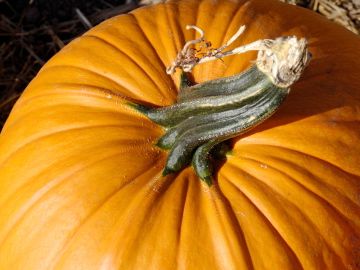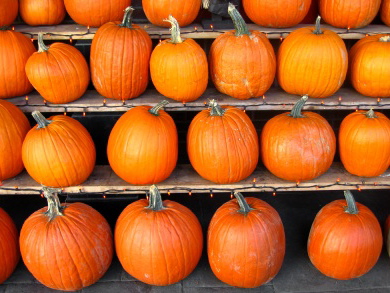
primary-image, l
(article, Keri Fisher)

primary-image, l
[%pageBreakSettings nobreak=true] When I was in college, just learning to bake, I bought a pumpkin so I could make pumpkin pie. How naïve I was. Not one of the dozen recipes I consulted called for fresh pumpkin, just canned. I had no idea what to do with the orange beast on my chipped Formica counter. For something so ingrained in our culture — where would our autumns be without pumpkin pie and jack o’ lanterns? — pumpkins are unknown in most American home kitchens. [[block(sidebar). h1.Featured recipes]] My pumpkin purchase happened almost 20 years ago, but things haven't changed much for the humble pumpkin since then. Folks buy pumpkins for decoration or carving or, occasionally, for seeds, but few actually cook them. Why not? Pumpkins are unbelievably good for you and, once you wrangle one home, relatively easy to prepare. My sister, a fiction writer, wrote a short story years ago in which the protagonist set out to solve the world hunger crisis by growing giant pumpkins. Though most pumpkins, including the standard Connecticut Field pumpkin that we're most familiar with, weigh around 10 pounds, there are giant pumpkin species — like the Big Max and the Mammoth Gold — that can reach 100 pounds in home gardens. And serious pumpkin growers can produce babies that, upon maturity, bust the scales at more than 1,000 pounds. My sister's idea wasn't completely absurd. Pumpkins of all sizes are packed with vitamins and carotenoids, a type of antioxidant that can help reduce the risk of many forms of cancer, lower rates of heart disease and macular degeneration, and boost immunity. Even the pumpkin’s relatively puny seeds are loaded with vitamin E, iron, magnesium, potassium, and zinc, along with omega-6 and omega-3 fatty acids. [%image reference-image float=right width=400 caption="Fall pumpkins for sale."] Pumpkins seem like a quintessentially American food, in part because of the iconic pumpkin pie, but pumpkins are in fact part of the culinary traditions of numerous cultures. Pumpkin's warm, earthy flavor makes it readily adaptable for any number of dishes. In Italy, pumpkin is used as ravioli stuffing, while in Thailand, small pumpkins are filled with custard. In India, pumpkin turns up in many curries, and in Japan, small pieces are fried in tempura batter. Roasted pumpkin makes a great easy side dish, but you can also cook the flesh down into pumpkin purée. Flavor the purée with maple syrup, heavy cream, and cinnamon, and you've got another good side dish. Thin the purée with stock, and you've got the base for pumpkin soup. [[block(sidebar). h1.How to roast pumpkin seeds Preheat the oven to 400 degrees. Rinse the seeds, being careful to remove the pulp. Grease a large baking sheet. Spread seeds in an even layer on the prepared baking sheet and salt lightly. Cook until seeds are dry and just beginning to brown at edges, about 15 minutes. Cool and store in an airtight container. ]] Pumpkin really shines, however, in baked goods, where it adds moisture and a wallop of flavor. You'll often see it in cakes, muffins, quick breads, cookies, and scones. My favorite version of the pumpkin muffin is Pumpkin Apple Muffins with White Chocolate Glaze; it's nothing more than a pumpkin-enhanced spice cake topped with a drizzle of chocolatey glaze. You can cook virtually any type of pumpkin with good results. Most supermarkets don't offer much variety, just the traditional jack o' lantern pumpkins. But if you can find a good market that sells other varieties, look for smaller sugar pumpkins, which weigh less than 5 pounds each and have a denser, less stringy flesh than larger standard pumpkins. Don't be fooled by color; cheese pumpkins are a favorite for pies, but are tan rather than deep orange. When choosing any size of pumpkin, look for a smooth, unblemished skin and a solid weight for its size. You probably won’t come across a 100-pound pumpkin at the store. But one of those monsters would certainly make a lot of cakes and pies and soup. Maybe my sister's on to something after all. p(bio). Cookbook author Keri Fisher (One Cake, One Hundred Desserts) has written for Saveur, Gastronomica, and Cook's Illustrated._ She lives outside Philadelphia with her sister, her husband, and her three children, and keeps a blog about living in a communal household.

reference-image, l

featurette-image, l